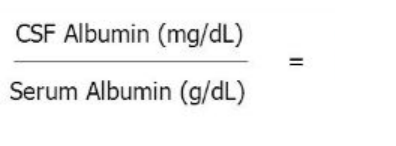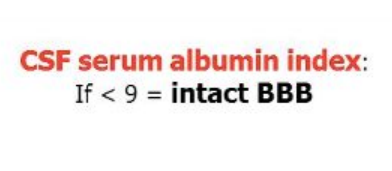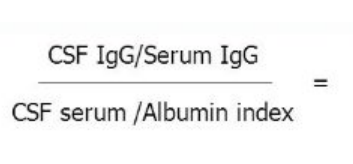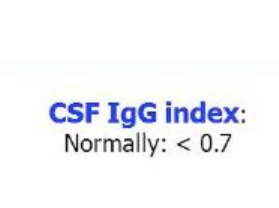Unit 12 body fluids
Deciphering Exudates and Transudates Algorithm: Is the specimen cloudy? No. Then...
Likely a Transudate
Deciphering Exudates and Transudates Algorithm: Is the specimen cloudy? Yes. Then...
Likely an Exudate
Deciphering Exudates and Transudates Algorithm: Is the glucose low and protein high? No then...
Likely a Transudate
Deciphering Exudates and Transudates Algorithm: Is the glucose low and protein high? Yes then...
Likely an Exudate
Deciphering Exudates and Transudates Algorithm: Is there over
5000
PMNs/mL? No then...
Likely a Transudate
Deciphering Exudates and Transudates Algorithm: Is there over
5000
PMNs/mL? Yes then
Likely an Exudate
What is the definition of: Transudate -
an effusion which is a filtrate of the plasma
What is the definition of: Exudate -
an effusion which is protein-rich and usually caused by an infection or cancer, likely contains inflammatory cells and occasionally pus
What is the definition of: Xanthochromia
- a yellowish tinge to a CSF sample, indicating prior bleeding into the CSF
What is the definition of: Chylous
- an effusion which is made up of pus and inflammatory cells
What is the definition of: Pseudochylous
- an effusion which has high levels of cholesterol
What is the definition of: Paracentesis -
obtaining fluid through a large bore needle inserted into the peritoneal cavity
What is the definition of: Thoracentesis
- obtaining fluid through a large bore needle inserted into the pleural cavity
What is the definition of: Arthrocentesis
- obtaining fluid through a large bore needle inserted into the joint
What is the definition of: Ascites
- Pathologic accumulation of fluid in the peritoneal cavity
What is the definition of: Effusion
- Pathologic accumulation of fluid in most other body cavities
Joint aspirates and urine samples may have extra crystals in them if?
they are refrigerated
Crystals in the sample may dissolve if?
left at room temperature
Transport must be rapid enough to?
to not allow for degradation of the specimen
Lactate may increase due to?
anaerobic metabolism of cells
What is the 1st tube for a CSF order?
Storage or for Cytology analysis (can vary depending on the lab)
What is the 2nd tube for a CSF order?
Chemistry and Serology
What is the 3rd tube for a CSF order?
Microbiology
What is the 4th tube for a CSF order?
Hematology
For Pleural Effusion, what do the following suggest/indicate: Milky consistency?
chylothorax (lymphatic obstruction)
For Pleural Effusion, what do the following suggest/indicate: Putrid odor suggests
anaerobic empyema
For Pleural Effusion, what do the following suggest/indicate: Black Pleural Fluid
malignant melanoma, non-small cell lung carcinoma (NSCLC), ruptured pancreatic pseudocyst, or charcoal-containing empyema
Ascites is an abnormal collection of fluid in the peritoneal cavity due to either?
portal hypertension or low serum osmolality
What is the specific gravity for transudates?
<1.010
What is the specific gravity for exudates?
>1.020
What situations are pericardial fluid order?
1.Therapeutic pericardiocentesis for cardiac tamponade
2.Clinical suspicion of purulent, tuberculous, or neoplastic pericarditis
3.Patients with large pericardial effusions of unknown etiology
What are the 4 categories of synovial effusions?
1.Inflammatory
2.Noninflammatory
3.Hemorrhagic
4.Septic
Normal synovial fluid is?
viscous
What is routine for Synovial Testing?
Gross examination (color, clarity)
Leukocyte counts
Gram stain and bacterial culture (aerobic and anaerobic)
Crystal examination with polarizing filters
Uric acid
What is the presence of LDH associated with in synovial fluid?
Leukocytes, WBCs
Amniocentesis is traditionally taken at 15-18 weeks gestation to assess for?
genetic disorders
When testing for Preeclampsia what does the following indicate: Hemolysis
Elevated AST, ACP, LD
When testing for Preeclampsia what does the following indicate:
AST, ALT, ALP
Elevated Liver enzymes
When testing for Preeclampsia what does the following indicate: Profound thrombocytopenia, (<60,000/uL)
Low Platelets
The only reason for seminal fluid assessment is to?
evaluate for infertility
What is evaluated in Seminal Fluid?
Ejaculate volume, total sperm count, concentration, shape of the head, and movement of the sperm are all assessed under a microscope
When dealing with a bloody tap, What is a Traumatic Tap?
The first tube is quite bloody and the blood lessens in each subsequent tube
When dealing with a bloody tap, What is a Subarachnoid Hemorrhage?
The first tube is quite bloody and the last tube is just as bloody
When dealing with a bloody tap, What does a Yellow or Brown CSF indicate?
that old, oxidized blood is present in the CSF
For CSF Glucose and Protein Culture is ALWAYS performed to rule-out?
a bacterial source because >10% of bacterial meningitides begin with a lymphocytosis
With CSF Glucose and Protein. What lab values indicate: Bacterial meningitis
Glucose ↓↓ WBCs ↑↑ Neutrophils ↑ Protein ↑
With CSF Glucose and Protein. What lab values indicate:Viral infection
Glucose ↓ WBCs ↑ Lymphocytes ↑ Protein ↑
With CSF Glucose and Protein. What lab values indicate: Brain Tumor
Glucose N WBCs N Malignant Cells Protein ↑
With CSF Glucose and Protein. What lab values indicate: Traumatic tap
Glucose N WBCs ↑ All cells ↑ Protein ↑
With CSF Glucose and Protein. What lab values indicate: Multiple Sclerosis -
Glucose N WBCs N T cells ↑ Protein ↑ (IgG)
The presence of oligoclonal bands in the CSF is indicative of?
multiple sclerosis
For the IgG index to aid in diagnosis of demyelinating diseases such as multiple sclerosis: CSF IgG index =
(CSF IgG/serum IgG) / (CSF albumin/serum albumin)
Normal CSF IgG index is <0.73
For Integrity of the Blood Brain Barrier Assessment:
CSF/serum Albumin index =
CSF albumin (mg/dL) / serum albumin (g/dL)
An index <9 indicates an intact blood brain barrier
What is the meaning of an elevated CSF-serum albumin index?
There is more protein in the CSF than there should be. This tells you that the blood brain barrier is potentially compromised because protein is leaking from the serum into the CSF.
The lab findings for Normal Pleural Fluid are?
Clear ultrafiltrate
Protein < 2 g/dL
< 1000 WBCs /mm3
Glucose at normal serum levels
Pleural LDH < 50% Plasma LDH
The lab findings for Bacterial Pleural Effusion are?
Cloudy ultrafiltrate
Protein >> 2 g/dL
>> 1000 WBCs /mm3
Glucose << 120 mg/dL
Pleural LDH >> 50% Plasma LDH
Pleural fluid glucose <30-50 mg/dL suggests ?
malignant effusion and very few other diseases
Pleural LDH levels >1000 mg indicate?
rheumatoid effusion, malignant effusion, Pneumocystis jiroveci, or empyema
For Paracentesis Serum to Ascites Albumin Gradient (SAAG) If the ratio is ≥ 1.1?
portal hypertension
For Paracentesis Serum to Ascites Albumin Gradient (SAAG) - If the ratio is < 1.1
NOT portal hypertension
The correct order to perform Paracentesis is
1.remove serous fluids from compressing a vital organ
2.determine the pathologic cause of an effusion
classify the effusion as either a transudate or exudate
Ascites is formed by these methods:
- High blood pressure in the portal veins
- low plasma oncotic pressure
- higher oncotic pressure in the abdominal cavity
- liver failure
For Peritoneal Fluid Assays, What are the expected findings for: Amylase -
“Normal” is ~40 IU/L, but is increased due to pancreatitis or bowel perforation up to 2000 IU/L
For Peritoneal Fluid Assays, What are the expected findings for: LDH -
Normal ratio for peritoneal fluid:serum LDH is 0.4. Spontaneous Bacterial Peritonitis (SBP) can approach a ratio of 1, but if the ratio increases above 1, the cause is likely either infection, bowel perforation, or tumor
For Peritoneal Fluid Assays, What are the expected findings for: CEA -
Elevated if peritoneal carcinomatosis is due to a primary colon cancer
For Peritoneal Fluid Assays, What are the expected findings for: Serum Pro-BNP
- Elevated if the ascitic fluid is due to heart failure
what is Pericardial Effusion Generally ordered with?
1.Serum electrolytes
2.CBC c diff
3.Cardiac biomarker levels (e.g. Tn-I, CK-MB, LDH)
Other markers of inflammation (e.g. ESR)
A 55-year-old male has a SAAG of 0.9, neutrophil count of 260 cells/um. What is the likely cause of his effusion?
The effusion is some sort of exudate, so the most common reasons would be an infection or malignancy.
When testing for uric acid crystals or calcium phosphate crystals, care must be taken to provide the lab with the sample immediately otherwise?
the crystals may dissolve
Synovial fluid samples should be diluted in?
normal saline if necessary
Gout is made up of?
monosodium urate crystals
Pseudogout is made up of ?
Calcium pyrophosphate crystals
Elevated results of Δ A450 are seen in
Hemolytic Disease of the Fetus and Newborn
___is commonly performed and is generally the primary indication for obtaining AF "Amniotic Fluid" between 13-15 weeks
genetic testing
What tests may help you to differentiate between urine and amniotic fluid?
1.Urea
2.Glucose
3.Creatinine
4.Protein
note: Urine should have lower values of glucose and protein and higher values for urea and creatinine
Name four tests used to assess fetal lung maturity
FSI, Lamellar body counts, L/S ratio, and Phosphatidylglycerol
Infants with a positive CFTR screen should undergo a sweat chloride test. An elevated sweat chloride is seen in?
cystic fibrosis, but is not sufficient for diagnosis. A genetic confirmation of the mutation is necessary for diagnosis.
In order to officially diagnose an exudate, the specimen MUST have?
an elevated total protein ratio and LD ratio
What are the indicators of: Transudate
straw-colored to amber
clear
normal glucose
normal protein
normal WBC
What are the indicators of: Exudate
Brown, yellow, green, etc.
Milky
low glucose
high protein
high WBC
What are the Causes of Transudate?
Caused by something like increased oncotic pressure (ascites), increased hydrostatic pressure (congestive heart failure), or renal failure
What are the Causes of Exudate?
Caused by an infection, autoimmune diseases, and occasionally cancer. An exudate may have a large amount of pus and inflammatory cells.
Remember, an exudate must have an elevated CSF:Serum protein ratio and LD ratio to be diagnosed properly
What are Light’s Criteria for: Pleural Fluid Exudates?
1.Pleural fluid protein : Serum protein = > 0.5
2.Pleural fluid protein >2.9 g/dL
3.Pleural fluid LDH : Serum LDH = > 0.45
4.Pleural fluid LDH > 0.45 x the upper limit of normal for Serum LDH
5.Pleural fluid Cholesterol > 45 mg/dL
If none of these are true, then the fluid is classified as a transudate
What are the reference ranges for Seminal Fluid Analysis?
Volume 1.5 - 5 mL
Hyperviscosity may impair sperm motility
pH should be between 7.2-7.8
Zinc allows for the sperm to develop properly
ACP is present in prostatic secretions
A newly-minted resident physician tries his luck to get a clean tap
on an elderly
patient after a fall down the stairs. Here are what
the tubes look like:
Tube 1: Grossly Bloody
Tube 2: Grossly
Bloody
Tube 3: Moderately Bloody
Tube 4: Moderately Bloody
Don’t be fooled just because the concentration of blood appears to be decreasing. It is likely decreasing because the patient has a subarachnoid hemorrhage, but the resident also nicked an artery with the needle. So, the first couple tubes had the hemorrhage blood in the CSF and the additional blood from the venous system. Tube 3 has less additional blood, and Tube 4 had even less. So this would still be a subarachnoid hemorrhage with a traumatic tap superimposed on top.




What disease is associated with an elevated sweat chloride?
Cystic Fibrosis
1. A 74-year-old female complains of knee pain. She is taking
Warfarin, Aspirin currently, and
also metronidazole for a pesky
infection that just won’t go away. After a synovial fluid
aspiration,
the results come back as Red/Brown opaque fluid with
7,000 WBC/mL, 43 Neutrophils/mL,
TNTC RBCs, and a glucose value
of 10 mg/dL. What is the classification of her synovial fluid?
A.
Noninflammatory
B. Inflammatory
C. Infectious
D. Hemorrhagic
She is taking Warfarin and the Metronidazole which will interact.
Metronidazole will increase the Warfarin levels, causing bleeding
that
is difficult to stop
A 28-year-old female presents to the physician with a fever and
kidney stones. She is 35-weeks along her current pregnancy and is
worried about the health of the baby. The physician is as well and
schedules her for an urgent induction of labor. Before this is begun,
she is given steroids to help the baby survive. Even though amniotic
fluid will likely not be taken before deliver, the administration of
steroids will likely most directly affect the results of
which
test?
A. ΔA450
B. AFP
C. Bilirubin
D.
L/S ratio
This is a test that measures fetal lung maturity. Mature fetal lungs
produce more Lecithin than they do Sphingomyelin and a ratio >2
is
considered to indicate that the fetus has mature lungs. If the
lungs are not mature, then steroids are given to accelerate the process
A 22-year-old female has otorrhea (clear fluid flowing out of her
hear) after a motorcycle crash with her boyfriend. She presents to the
emergency department very confused. The emergency physician needs to
determine if he needs to refer her to neurosurgery and decides to get
a CSF serum albumin index. Her CSF Albumin is 11 mg/dL and her Serum
Albumin is 4.7
g/dL. What do these results indicate?
A.
Damage to the blood brain barrier
B. Intact blood brain
barrier
C. No significance
D. Traumatic brain injury
Her CSF serum albumin index is 2.3 which is less than 9 and indicates that the blood brain barrier is keeping an adequate amount of proteins out of the cerebrospinal fluid in the subarachnoid space
what kind of panel would you get for the following synovial fluid testing: Normal
Clarity: Transparent
Color: Clear
WBCs: 0-150
PMNs: <25
RBCs: None
Glucose (mg/dL):0-10
what kind of panel would you get for the following synovial fluid testing: Group I Noninflammatory
Clarity: Transparent
Color: Xanthochromic
WBCs: <3000
PMNs: <30
RBCs: None
Glucose (mg/dL): 0-10
what kind of panel would you get for the following synovial fluid testing: Group II Inflammatory
Clarity: Transparent/Opaque
Color: Xanthochromic to bloody
WBCs: 3000-75,000
PMNs: >50
RBCs: None
Glucose (mg/dL): 0-40
what kind of panel would you get for the following synovial fluid testing: Group III Infectious
Clarity: Opaque
Color: White
WBCs: 50,000-200,000
PMNs: >90
RBCs: Yes
Glucose (mg/dL): 20-100
what kind of panel would you get for the following synovial fluid testing: Group IV Hemorrhagic
Clarity: Opaque
Color: Red/Brown to Xanthochromic
WBCs: 50-10,000
PMNs: <50
RBCs: Yes
Glucose (mg/dL): 0-20